Why a Cycling Tour Is the Best Way to See Puglia
I like to ride a bike, but I’m not a maniac cyclist like my husband who is happiest in Lycra, grinding up some steep mountain hill. My bicycles usually have a basket and a bell. When we were recently planning a family vacation, he, as always, suggested a cycling trip; I, as always, shot him down. I like our vacations to have an active element, but I also believe a holiday should not be punitive.
Then he sent me a link to a ”family cycling adventure” in Puglia. Yes, it would involve time on a bike—but also epic scenery, cultural outings, and plush hotels. For our ten-year-old daughter Sylvie, there would be regular plunges into the sea, as well as pasta, pizza, and gelato. I said yes.
Puglia, the vibrant region of Italy’s heel, evokes the country’s pre-cruise ship era. It’s where Italians go on vacation, drawn by the 500 miles of coastline framed by the Ionian Sea to the East and the Adriatic to the West, unspoiled hilltop Medieval towns, ancient archeological sites, and life-changing food. Until a few years ago, Puglia’s many charms were largely a secret, which is why a fashionable crowd, from Bella Hadid to Emily Rajatkowski to native son Riccardo Tisci have been able to swim in coves and sip Calafurnia Negroamaro Rosato unbothered.
After a quick hourlong flight from Rome to the Brindisi airport, we were met in a sleek DuVine Cycling + Adventure Co van by a pair of genial guides. There was Davide, a courtly former chef who once ran a restaurant in Scotland (he jokes that he speaks Italian with a Scottish accent) and Paulo, a former diving instructor who has lived all over the world and became a great favorite of older ladies who were mock-scandalized by his jaunty banter.
Off we went to the small town of Minvervino di Lecce, to the Palazzo Ducale Venturi, a meticulously restored former 16th century palace, now a chic boutique hotel with 13 airy rooms. After a poolside lunch among the drowsy bees in its honey-scented garden—pillowy, otherworldly Buratta, briny grilled anchovies, sweet cherry tomatoes and basil, and just-picked apricots still warm from the sun—we were given a safety talk, hand signals demonstration, and bike fitting. They told us that one guide would lead our small group, while the other trailed discreetly in the van.
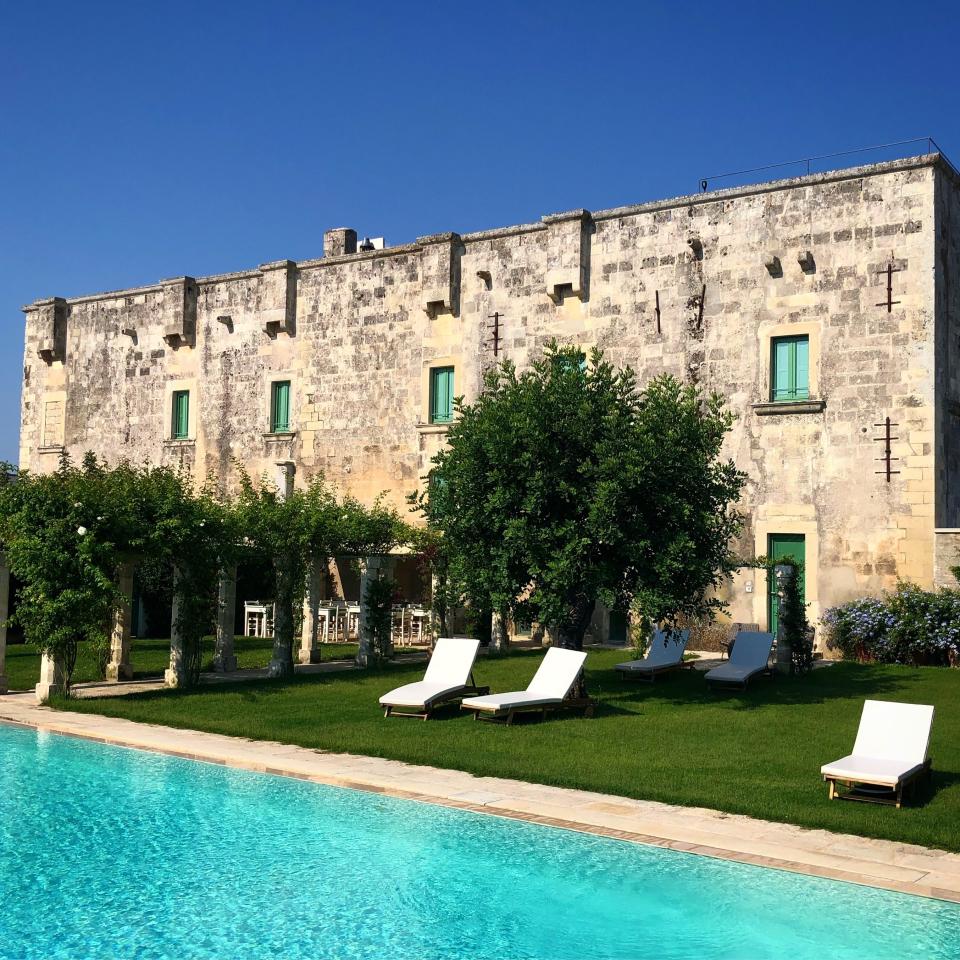
Then, they filled our water bottles (in an Italian touch, they added cut lemons and wild mint) and we hit the road. As we whizzed past endless olive groves—Puglia is the country’s largest oil-producing region—I had to fight my uneasiness about riding on the open road. Having driven in Italy many times, I was used to Italians’ love of speed and creative use of hand gestures. But Davide had reassured me that bike-loving Italians are largely respectful of cyclists, and that proved to be true. With the exception of a handful of drivers, most would slow down and carefully edge around us; most beeps I heard were a warning rather than road rage. Traveling in a group also boosts your visibility, and Tom and I kept Sylvie between us for extra safety.
Cycling makes you both hyper-alert and hyper-relaxed. Each day, we aimed for 18 miles (Tom went longer by himself). I had hastily trained on a spin bike for a month, which I found to be a joyless slog; it was much easier with gorgeous views as a distraction. I became attuned to scents, too: wafts of rosemary, pine needles, bread baking in a pasticceria.
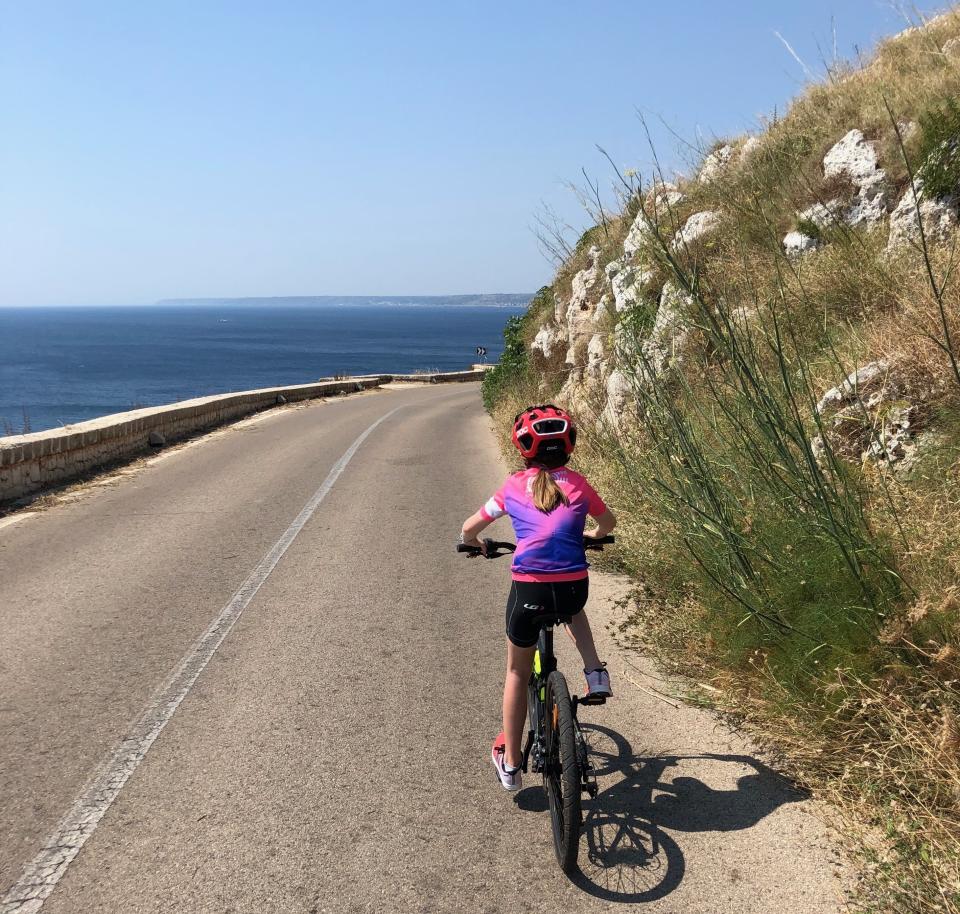
In the summer Puglian heat, Sylvie’s energy usually began to flag at the 10-mile mark, at which point Davide could be relied on to pull the van over and tell her that he could really use some company. (Dignity intact, she would gratefully clamber in.)
That first evening, we bolted down our dinner. (Cycling burns an estimated 500 calories per hour, depending on your weight and speed, so despite eating daily multi-course meals, I returned home one pound lighter.) Puglia remains an agricultural region, and the food is local, simply prepared, and vegetable-based (vegetarians can happily make a meal of the abundant antipasti, such as pure di fave e cicorie, a flavorful puree of fava beans and wilted chicory, and pasta). We feasted on grilled eggplant and fish, fat olives, and sumptuous regional wines such as Salice Salentino and Primitivo.
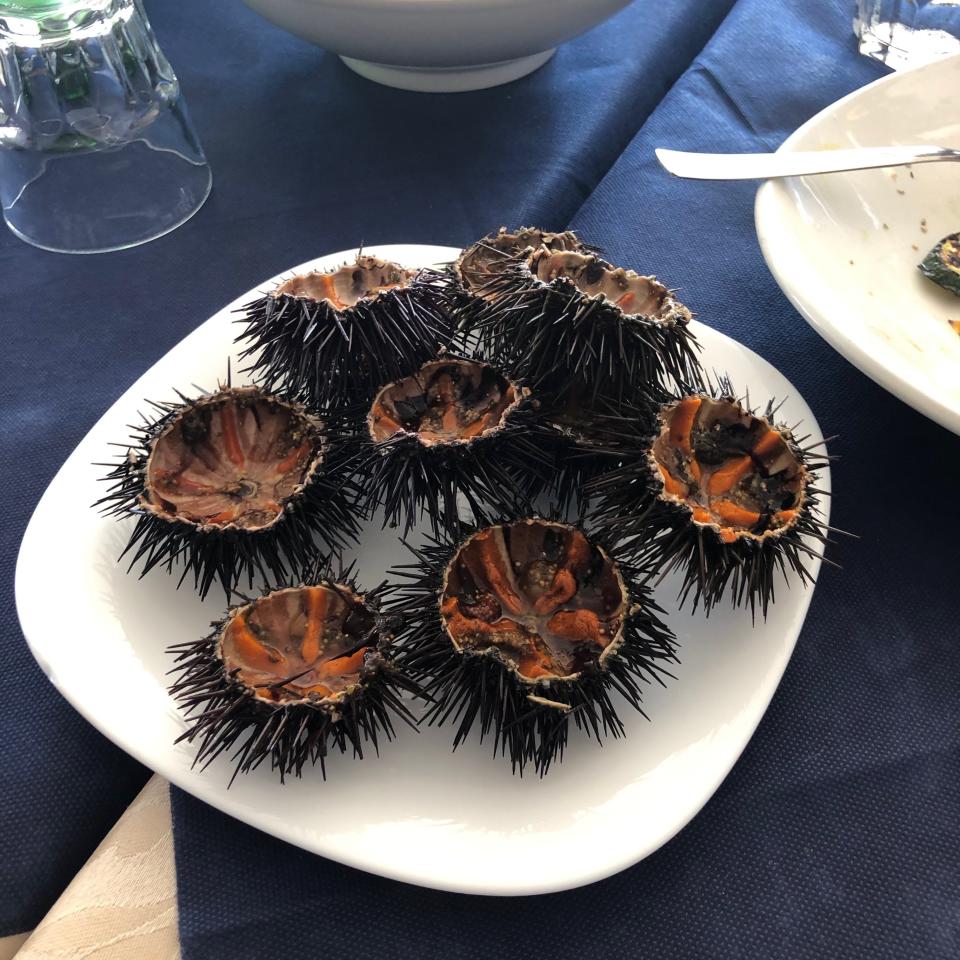
Each day was a delightful mix of pedaling alongside the glittering sea or through olive groves, swimming in blue coves, and cultural jaunts such as pasta-making at a masseria, one of the ranchlike compounds that dot the landscape. Or we’d pause for espresso in a pastel-colored midcentury seaside bakery.
One morning we wound through the rolling fields of the Itria Valley, perfumed by the Machia Mediterranea—rosemary, oregano, juniper—to Alborobello, a picture-postcard town of whitewashed conical stone buildings called trulli, unique to the region and many of which are hundreds of years old. We stopped for a mozzarella-making lesson, followed by a homemade lunch made by Carmela, a local woman famous for her cooking. Sated and drowsy, we checked into Borgo Canonica, an elegant, much-photographed hotel comprised of dozens of sparkling white trulli.
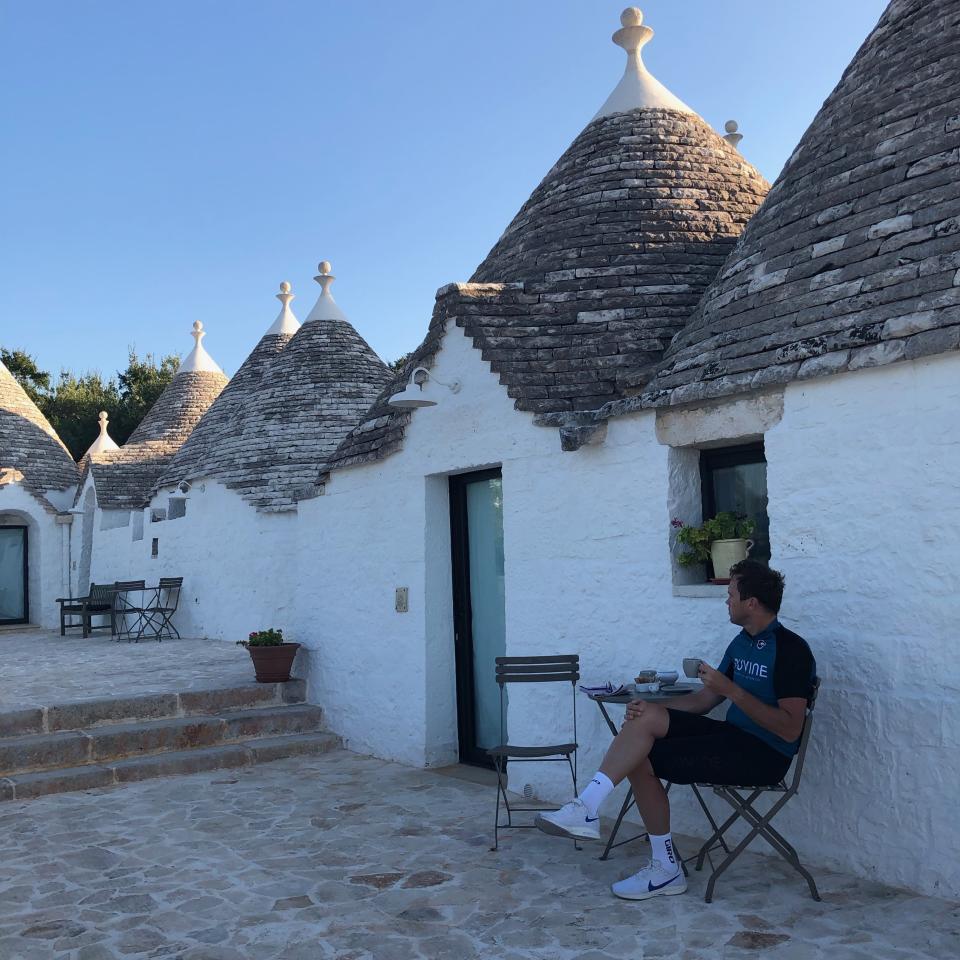
On another day, we headed to the city of Egnazia, an ancient port and former center of commerce, for an afternoon of snorkeling around the crumbling half-submerged walls. On the sea floor, we could see broken shards of clay amorphae used to transport oil and wine, tossed overboard by sailors thousands of years ago. That night, we bunked at the sprawlingly plush Borgo Egnazia, site of Justin Timberlake’s wedding, where I had the deepest sleep of my life (intense exercise and sunshine has a way of staving off jet lag).
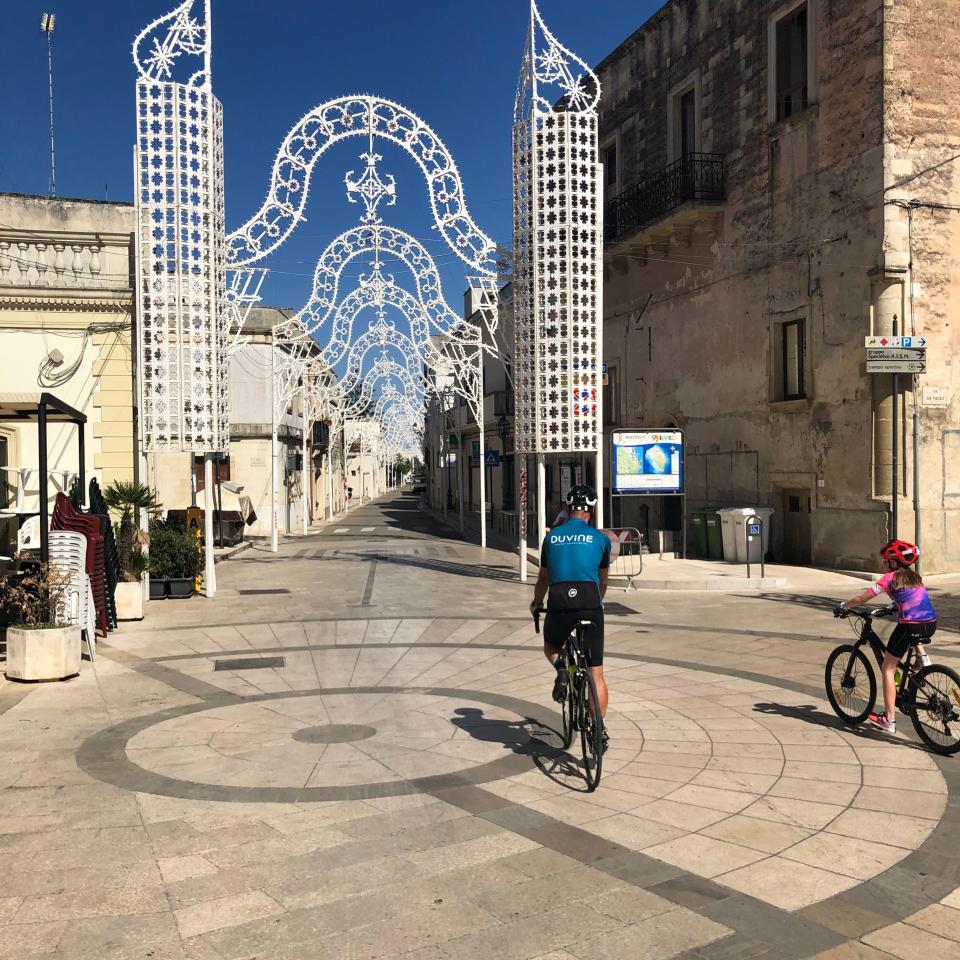
I must admit that now I know why Tom is so zealous about cycling. It’s the perfect way to instantly immerse yourself in a region and get a genuine feel for what it’s about. As we rode through villages, scenes of Pugliese daily life flashed by. We passed a bride and groom emerging from a small church, cats lazing in the sun, old guys playing dominos at a card table, women in housecoats sweeping, a gaggle of fisherman smoking and repairing nets. One morning, I received a nod from a septuagenarian cyclist, his shirt extravagantly open to the navel, gold chains winking in the sun.
If one of the guides sensed that our stamina was waning (mine and Sylvie’s, anyway) they’d find a way to spur us on. Davide would pull us over to pick some wild fennel and oregano and invite us to bury our noses in it, or pluck a sun-warmed plum from a tree and urge us to eat it. One scorching afternoon when I was ready to climb into the van, Paulo, who was leading the way, looked back at me and grinned. “Four kilometers of beauty are right down this hill!” he called over his shoulder. “I promise you!” That was enough, and I pedaled on.
Originally Appeared on Vogue

